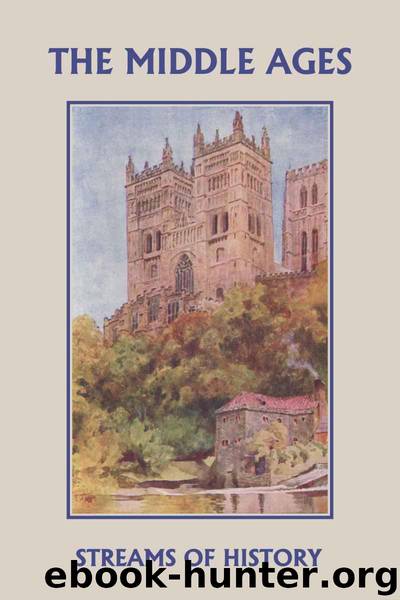Streams of History: The Middle Ages (Yesterday's Classics) by Kemp Ellwood W

Author:Kemp, Ellwood W. [Kemp, Ellwood W.]
Language: eng
Format: epub
Tags: Juvenile Fiction
ISBN: 9781599152578
Publisher: Yesterday's Classics
Published: 2010-11-10T14:51:05.898000+00:00
The Crusades, and How the Thought of Europe Was Enlarged through Them
1096–1276 A.D.
DURING the period from about 1100 to 1300 A.D., the Crusade movements eastward were going on. In all our study up to this time we have seen the stream of history gradually flowing westward setting up and overturning great nations and cities; but now for a time the direction is changed, and thousands of people go back to Asia over the same ways and routes that the Eastern people had used in entering Europe. The immediate cause of the Crusade movement was the harsh treatment received by the Christian pilgrims when they went to visit the sepulcher of Christ in Jerusalem. The religion of the people who held Jerusalem and all southwestern Asia at this time was the Mohammedan. The Mohammedans, who arose in Arabia under Mohammed, in 622, had been busy conquering the inhabitants of all southwestern Asia until about 750 A.D., when there was little more left in that region for them to conquer. Then they set to work to learn the ideas of medicine, philosophy, sculpture, painting, architecture and literature, which had been spread out over this country centuries before by the Greeks under Alexander, and further developed by the Persians. By the time of the Crusades, the Mohammedans were the best educated people in the world, knowing much more about science, philosophy, medicine, commerce and art than did the Teutons, of western Europe, whom we have just been studying about. As they became well educated, they became less fierce and warlike, and began to tolerate other religions besides their own, so that when the pilgrims from Europe began to go in large numbers to Jerusalem to worship, in the ninth, tenth and eleventh centuries, the Mohammedans received them kindly and let them travel back and forth unmolested. Jerusalem, as you can readily see, was a very sacred city in the eyes of the Christians, because it was the place where Christ walked and talked and worked with men, and contained his sepulcher and many things connected with his ministry. An old poet, writing of Jerusalem at that time, said: "She is chosen and hallowed by the Almighty. She attracts the faithful as the magnet attracts the steel, as the mother-sheep attracts the lamb with its milk, as the sea attracts the river to which it has given birth."
We have already seen how the monks in the monasteries valued the relics of departed saints and used them both in religious worship and as a means of curing disease. These journeys to the tomb of Christ were partly the outgrowth of the great reverence the people of western Europe had come to have for sacred relics and sacred places. By worshiping at the tomb of Christ they hoped to be forgiven for their sins, even if they had been very great. Then, any sacred relic which they might secure and bring home was of so much spiritual value that pilgrims were willing to undertake hard trips for that object alone.
Download
This site does not store any files on its server. We only index and link to content provided by other sites. Please contact the content providers to delete copyright contents if any and email us, we'll remove relevant links or contents immediately.
The Mayflower and the Pilgrims' New World by Nathaniel Philbrick(4428)
I'm Still Scared by Tomie dePaola(4324)
Bloody Times by James L. Swanson(4316)
Pocahontas by Joseph Bruchac(4183)
Bomb: The Race to Build--And Steal--The World's Most Dangerous Weapon (Newbery Honor Book) by Steve Sheinkin(3840)
Flesh and Blood So Cheap by Albert Marrin(3783)
An American Plague by Jim Murphy(3713)
Little Author in the Big Woods by Yona Zeldis McDonough(3462)
The Giant and How He Humbugged America by Jim Murphy(3397)
Hello, America by Livia Bitton-Jackson(3098)
The President Has Been Shot!": The Assassination of John F. Kennedy by Swanson James L(3056)
Harry Potter: A History of Magic by British Library(3003)
The Landing of the Pilgrims by James Daugherty(2894)
Gettysburg by Iain C. Martin(2786)
The Extraordinary Suzy Wright by Teri Kanefield(2655)
Ben Franklin's Almanac by Candace Fleming(2470)
The Impossible Rescue by Martin W. Sandler(2280)
Bloody Times: The Funeral of Abraham Lincoln and the Manhunt for Jefferson Davis by James L. Swanson(2063)
Who Was Louis Braille? by Margaret Frith(1945)
